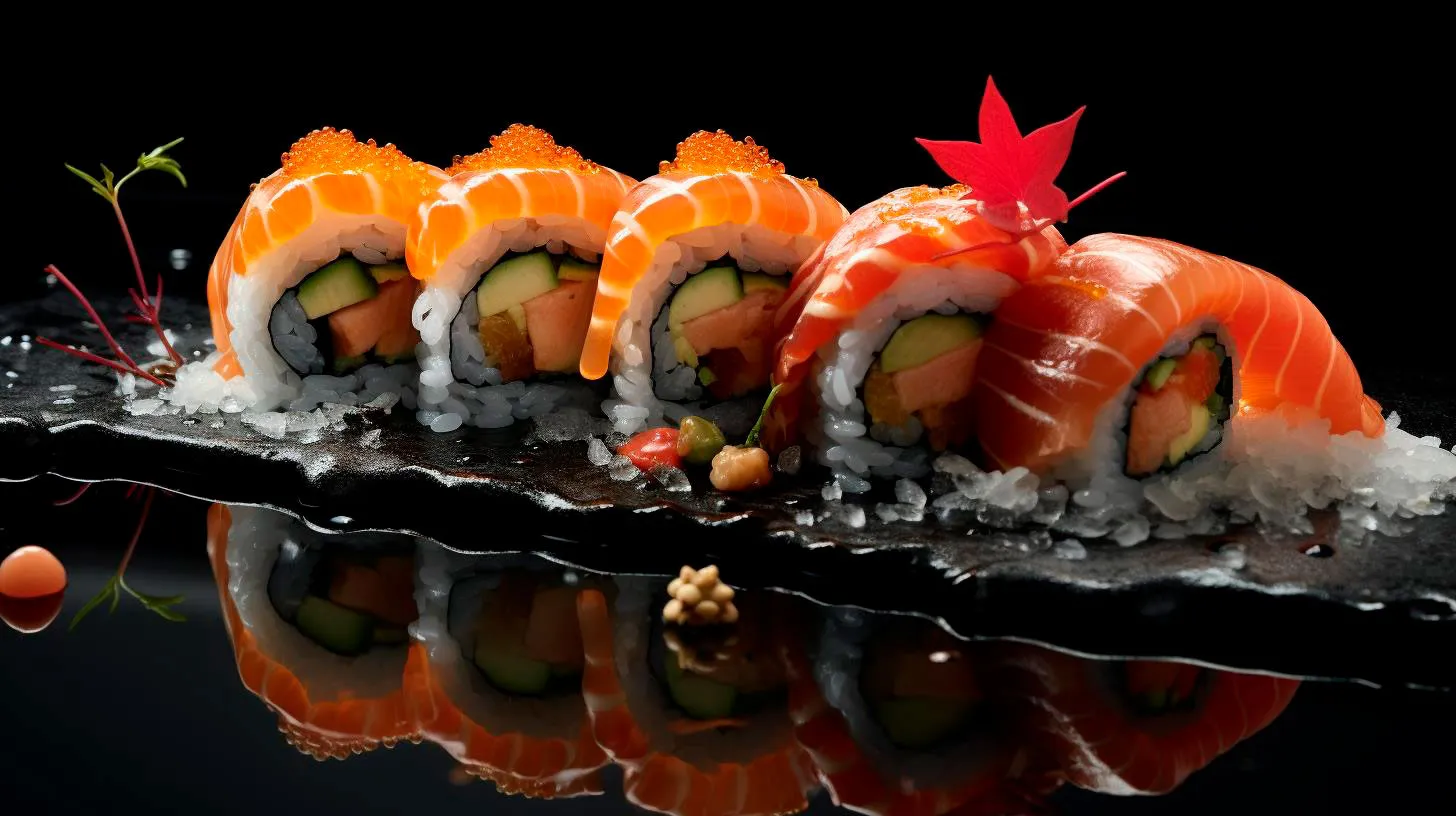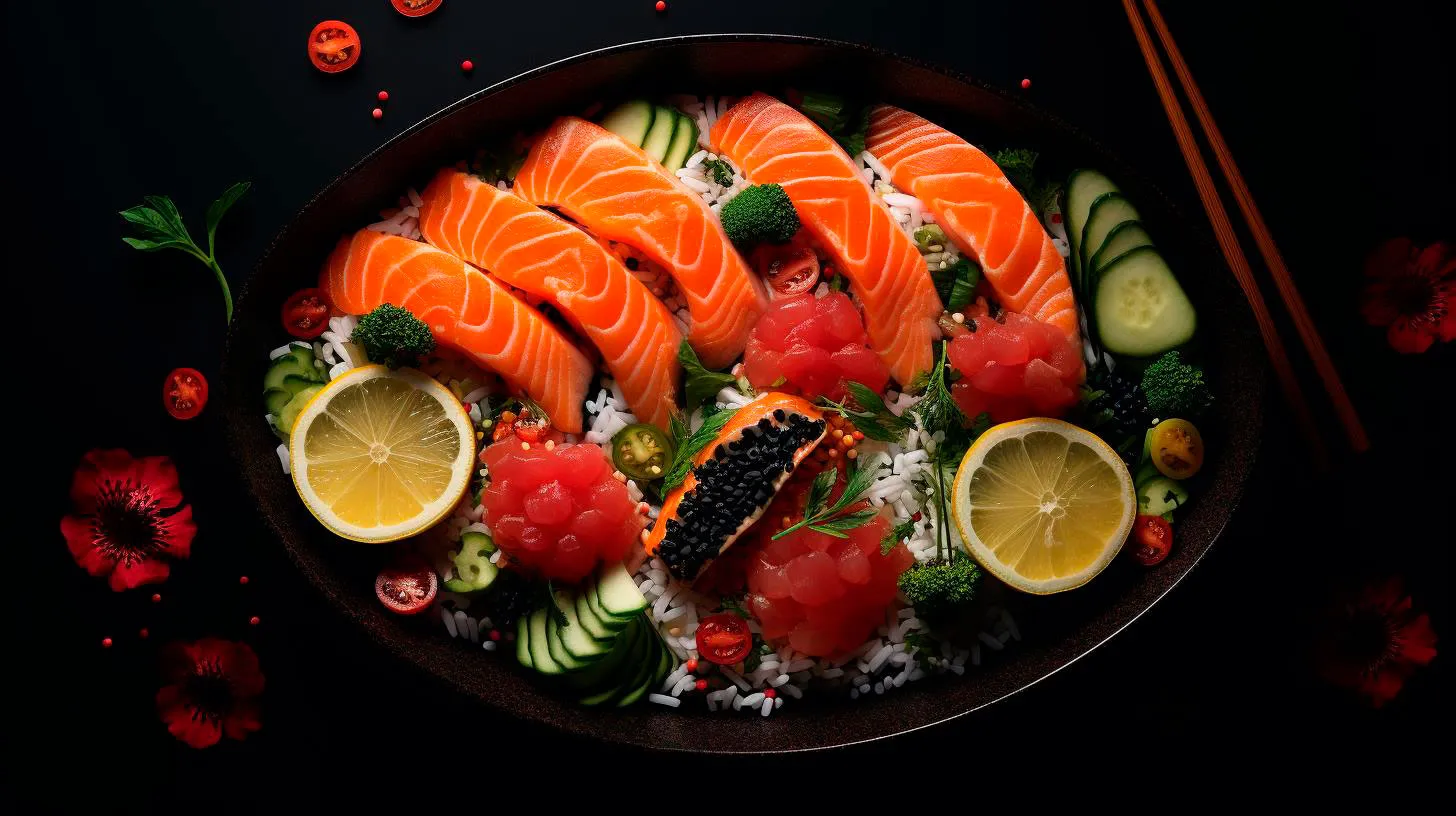From Fusion to Innovation: American Sushi with Modern Flair
In this article, we will explore the evolution of American sushi and how it has transformed into a modern fusion cuisine.
The Rise of American Sushi
Sushi has been an integral part of Japanese cuisine for centuries. However, when it was introduced to the United States in the 1960s, it underwent significant modifications to cater to the American palate. In the early days, traditional sushi rolls were typically made with cooked fish and ingredients that were more familiar to Americans, such as avocado and cucumber.
Over time, American sushi chefs began experimenting with non-traditional ingredients, incorporating elements from other cuisines, and creating innovative flavor combinations. The result was the birth of American sushi, a fusion of Japanese techniques with American ingredients and tastes.
Key Takeaways:
- American sushi combines traditional Japanese techniques with American flavors and ingredients.
- It was introduced to the United States in the 1960s and underwent modifications to suit the American palate.
- American sushi chefs started incorporating non-traditional ingredients and experimenting with different flavor combinations.
The Fusion of Flavors
American sushi incorporates a wide range of flavors and ingredients to offer a diverse culinary experience. While traditional Japanese sushi focuses on simplicity and natural flavors, American sushi embraces boldness and experimentation.
One popular example of American sushi innovation is the creation of sushi rolls that include ingredients like cream cheese, spicy mayonnaise, and tangy barbecue sauce. These additions bring new dimensions of flavor and texture to the traditional sushi roll.
Furthermore, American sushi also draws inspiration from other international cuisines. For instance, the use of Latin American flavors like cilantro, jalapeño, and chipotle adds a spicy and vibrant twist to the traditional sushi palette.
Key Takeaways:
- American sushi offers a diverse culinary experience with a fusion of flavors.
- Ingredients like cream cheese, spicy mayonnaise, and barbecue sauce are commonly used in American sushi rolls.
- Latin American flavors add a spicy and vibrant twist to American sushi.
The Role of Innovation
One of the defining characteristics of American sushi is its emphasis on innovation. American sushi chefs constantly push the boundaries of traditional sushi-making by incorporating new techniques, ingredients, and presentations.
One noteworthy example of sushi innovation is the creation of sushi burritos or sushi bowls. These inventive dishes combine the convenience of a burrito or bowl with the flavors and ingredients of sushi, creating a portable and customizable dining experience.
Moreover, American sushi chefs have also ventured into the realm of vegetarian and vegan sushi, catering to the increasing demand for plant-based options. This innovative approach allows individuals with different dietary preferences to enjoy the flavors and artistry of sushi.
Key Takeaways:
- American sushi chefs constantly innovate by introducing new techniques, ingredients, and presentations.
- Sushi burrito and sushi bowl are innovative creations that combine the convenience of popular American dishes with sushi.
- American sushi chefs cater to vegetarian and vegan preferences by offering plant-based sushi options.
The Advantages of American Sushi
American sushi offers several advantages that contribute to its growing popularity among food enthusiasts.
Firstly, the fusion of flavors and ingredients in American sushi allows for a wider variety of options, appealing to a broader audience. Whether you prefer traditional flavors or enjoy bold and unique combinations, there is an American sushi roll that suits your taste.
Secondly, the emphasis on innovation in American sushi brings excitement and novelty to the dining experience. With new creations and flavor profiles constantly emerging, American sushi keeps diners intrigued and eager to explore what’s next.
Lastly, the incorporation of non-traditional ingredients and international flavors in American sushi enhances accessibility and introduces sushi to those who may have been hesitant to try it before. By incorporating familiar flavors, American sushi makes this Japanese delicacy approachable and enticing for a wider range of individuals.
Key Takeaways:
- American sushi offers a wider variety of options, appealing to a broader audience.
- The emphasis on innovation keeps the dining experience exciting and novel.
- American sushi introduces sushi to a wider range of individuals through the incorporation of non-traditional ingredients and familiar flavors.
In conclusion, American sushi has emerged as a delightful fusion of traditional Japanese techniques and innovative American flavors. By pushing the boundaries of what sushi can be, American sushi chefs have created a culinary experience that appeals to a diverse range of tastes. The blend of flavors, the incorporation of new techniques, and the emphasis on innovation continue to shape the evolution of American sushi, offering an exciting gastronomic journey for sushi enthusiasts around the world.
Exploring the Key Differences: Japanese Sushi vs American Sushi
In this article, we’ll delve into the key differences that set Japanese sushi apart from its American counterpart.
1. Preparation Methods
Japanese sushi is renowned for its traditional preparation methods and meticulous attention to detail. On the other hand, American sushi often incorporates a fusion of flavors and techniques from various cuisines. Here are the fundamental differences in their preparation:
- Japanese Sushi: In Japan, sushi chefs undergo years of rigorous training to master the art of sushi-making. They focus on perfecting the skills required to handle and prepare raw fish, ensuring the utmost freshness and quality. Traditional Japanese sushi emphasizes simplicity, allowing the natural flavors of the ingredients to shine.
- American Sushi: American sushi, influenced by Western tastes, adds creative elements to the traditional Japanese style. It often includes unique combinations of ingredients, such as cream cheese, avocado, and even unconventional toppings like spicy mayo or crispy onions. This fusion approach aims to cater to a wider range of palates.
2. Ingredient Choices
When it comes to sushi, the ingredients play a crucial role in defining its flavors and overall experience. Here’s how Japanese and American sushi differ in terms of ingredient choices:
- Japanese Sushi: Traditional Japanese sushi relies heavily on seasonal, high-quality fish and seafood. Common ingredients include tuna, salmon, yellowtail, eel, and shrimp, all meticulously selected for their freshness and flavor. Japanese sushi also incorporates a variety of garnishes like wasabi, pickled ginger, and soy sauce to complement the fish.
- American Sushi: With its fusion approach, American sushi offers a plethora of ingredient options that go beyond traditional boundaries. While fresh fish remains a staple, American sushi introduces unconventional ingredients like cream cheese, avocado, and various vegetables. This diversification allows for unique flavor combinations and broader choices for sushi enthusiasts.
3. Presentation Styles
The presentation of sushi is an art form in itself. Japanese and American sushi vary not only in taste but also in their visual appeal. Here’s how they differ in presentation style:
- Japanese Sushi: In Japan, sushi presentation is minimalist and focuses on clean lines and simplicity. Sushi pieces are small, delicate, and aesthetically arranged on plates or platters. The beauty lies in the natural colors and textures of the ingredients, often garnished with edible flowers or decorative elements.
- American Sushi: American sushi presentation tends to be more vibrant and elaborate, with an emphasis on eye-catching arrangements. Sushi rolls, such as California rolls or spider rolls, are visually appealing and often topped with sauces, colorful tobiko (flying fish roe), or crispy tempura flakes for added texture and flavor.
4. Taste Profiles
Ultimately, the taste is what sets Japanese sushi and American sushi apart. Let’s take a closer look at the distinct flavors each style offers:
- Japanese Sushi: The essence of Japanese sushi lies in its simplicity. With the focus on showcasing the natural flavors of the ingredients, Japanese sushi tends to be more delicate and subtle. The combination of well-seasoned rice, fresh fish, and accompanying condiments creates a harmonious balance of flavors.
- American Sushi: American sushi pushes flavor boundaries, experimenting with diverse ingredients and condiments. The fusion of different cuisines adds depth and complexity to the taste profile, resulting in bolder and more pronounced flavors. Creaminess from ingredients like avocado and cream cheese, combined with unique sauces and toppings, contribute to the distinct American sushi experience.
Key Takeaways
Understanding the key differences between Japanese sushi and American sushi allows you to appreciate and enjoy both styles to their fullest extent. Here are the main takeaways:
- Japanese sushi relies on traditional preparation methods, emphasizing simplicity and quality ingredients.
- American sushi incorporates fusion flavors and techniques, offering a wider range of ingredient choices and creative combinations.
- Japanese sushi presentation is minimalist, while American sushi tends to be more vibrant and elaborate.
- Japanese sushi offers delicate and subtle flavors, while American sushi boasts bolder tastes and complex combinations.
Whether you’re a purist who appreciates the art of traditional sushi or an adventurous foodie seeking new flavor experiences, both Japanese and American sushi have something unique to offer. Indulge in their distinct flavors, presentation styles, and preparation techniques, and make the most of your sushi adventures!
Unveiling the Traditional Techniques Crafting Japanese Sushi
In this article, we will delve into these techniques, uncovering the secrets behind the creation of Japanese sushi.
The Essence of Japanese Sushi
Before we dive into the traditional techniques, it’s important to understand the essence of Japanese sushi. Sushi is not merely a collection of raw fish and rice; it’s a harmonious blend of flavors, textures, and meticulous craftsmanship. Each element of sushi, from the quality of the fish to the precision in cutting the ingredients, plays a crucial role in achieving the perfect balance.
The Traditional Techniques
1. Nigiri-zushi: One of the most recognized forms of sushi is Nigiri-zushi. This technique involves shaping a small mound of vinegared rice with a slice of raw fish on top. The chef’s expertise lies in achieving the perfect balance of rice and fish, ensuring the flavors complement each other.
- Key Takeaway: Nigiri-zushi highlights the delicate balance between high-quality fish and perfectly seasoned rice.
2. Maki-zushi: Maki-zushi, commonly known as sushi rolls, is created using a bamboo mat to tightly roll sushi rice and a variety of ingredients in a sheet of seaweed. The roll is then sliced into bite-sized pieces. This technique allows for creativity in combining different flavors and textures.
- Advantage: Maki-zushi offers endless possibilities for customization, making it a favorite among sushi lovers.
3. Chirashi-zushi: Chirashi-zushi, meaning “scattered sushi,” is a style where vinegared rice is topped with various ingredients, such as thinly sliced vegetables, cooked seafood, and tamago (Japanese omelet). This technique allows for a visually stunning presentation, often resembling a work of art.
- Feature: Chirashi-zushi is a versatile dish, providing a wide range of flavors and textures in each bite.
The Artistry and Precision
One of the most captivating aspects of Japanese sushi is the level of precision and artistry involved in its creation. The slicing of the fish, the shaping of the rice, and the arrangement of ingredients on the plate are all executed with meticulous care.
Japanese sushi chefs undergo years of training to perfect these techniques. They learn the delicate balance of flavors, master knife skills for precise cuts, and develop an eye for aesthetic presentation. It is through this dedication to craftsmanship that sushi becomes more than a meal; it becomes an art form.
Whether it’s the symphony of flavors in Nigiri-zushi or the visual masterpiece of Chirashi-zushi, each bite of Japanese sushi is crafted with unwavering attention to detail.
Key Takeaways
1. Japanese sushi is a culinary art form that combines flavors, textures, and meticulous craftsmanship.
2. Traditional techniques such as Nigiri-zushi, Maki-zushi, and Chirashi-zushi form the foundation of sushi-making.
3. Nigiri-zushi highlights the balance between high-quality fish and perfectly seasoned rice.
4. Maki-zushi offers endless possibilities for customization, appealing to diverse palates.
5. Chirashi-zushi allows for visually stunning presentations, making it a feast for the eyes as well as the taste buds.
6. Precision and artistry are integral to the creation of Japanese sushi.
7. Sushi chefs undergo extensive training to master the techniques and ensure exceptional quality.
In conclusion, Japanese sushi is a testament to the rich culinary heritage of Japan. Whether you are a sushi connoisseur or a first-time explorer, experiencing the traditional techniques and artistry behind Japanese sushi is an adventure that engages all the senses. The next time you savor a piece of sushi, appreciate the centuries-old craftsmanship that brings this iconic dish to life.
Rice and Raw Fish: The Essential Elements of Japanese Sushi
In this blog post, we will explore the essential elements of Japanese sushi, delving into its history, ingredients, and the art of sushi-making.
The Origins of Sushi
Sushi has a rich history that dates back centuries ago. Originally, sushi was not the fish-topped rice we know today. Instead, it was a preservation method used to ferment fish by packing it with rice. The resulting dish was enjoyed much later when the fish was consumed and the rice discarded. Over the years, this technique evolved, leading to the creation of Edomae sushi, which is the precursor to modern sushi.
The Key Ingredients
1. Rice: Sushi rice, also known as shari, is at the heart of this Japanese delicacy. It is short-grain rice that is cooked and seasoned with a mixture of rice vinegar, sugar, and salt. The stickiness and flavor of sushi rice play a crucial role in elevating the taste and texture of sushi rolls.
2. Fish and Seafood: The most common type of seafood used in sushi is raw fish, known as sashimi. Varieties such as tuna, salmon, and yellowtail are prized for their freshness, texture, and taste. Apart from fish, other seafood such as shrimp, squid, and octopus are also used in sushi preparations.
3. Vegetables and Other Fillings: While fish reigns supreme in traditional sushi, vegetables like cucumber, avocado, and pickled radish are frequently added to sushi rolls. These fillings provide contrasting textures, complement the fish, and add a refreshing crunch to each bite.
The Art of Sushi-Making
Creating sushi is an art form that requires skill, precision, and a deep understanding of flavors. Highly trained sushi chefs dedicate years to perfecting their craft. Here are some key techniques involved in sushi-making:
- Shari Preparation: The rice is cooked and seasoned, ensuring optimal stickiness and sushi rice flavor.
- Knife Skills: Sushi chefs employ precise knife techniques to cut fish and vegetables into thin slices that can be elegantly placed on top of the rice.
- Rolling Technique: Whether making hosomaki (thin rolls) or uramaki (inside-out rolls), a delicate touch is required to form perfectly cylindrical sushi rolls.
- Garnishing: Sushi chefs use a variety of garnishes such as wasabi, ginger, and soy sauce to enhance the presentation and flavor of sushi.
The Health Benefits of Sushi
Sushi not only delights the palate but also offers various health benefits:
- Sushi is a low-calorie food option, making it suitable for those watching their weight.
- Raw fish in sushi provides high-quality protein, omega-3 fatty acids, and essential vitamins and minerals.
- The inclusion of vegetables in sushi rolls adds fiber, vitamins, and antioxidants to the dish.
- The moderate consumption of sushi has been associated with a lower risk of heart disease and improved brain health.
Conclusion: A Culinary Delight
Sushi, with its perfect combination of vinegared rice and fresh fish, is an exquisite example of Japanese cuisine. Its origins, key ingredients, and the art of sushi-making make it a captivating dish that has stood the test of time. From its health benefits to the sheer pleasure of enjoying each bite, sushi continues to be a favorite choice for food enthusiasts worldwide.
So, the next time you savor a piece of sushi, take a moment to appreciate the expert craftsmanship and cultural significance packed within this humble dish.


